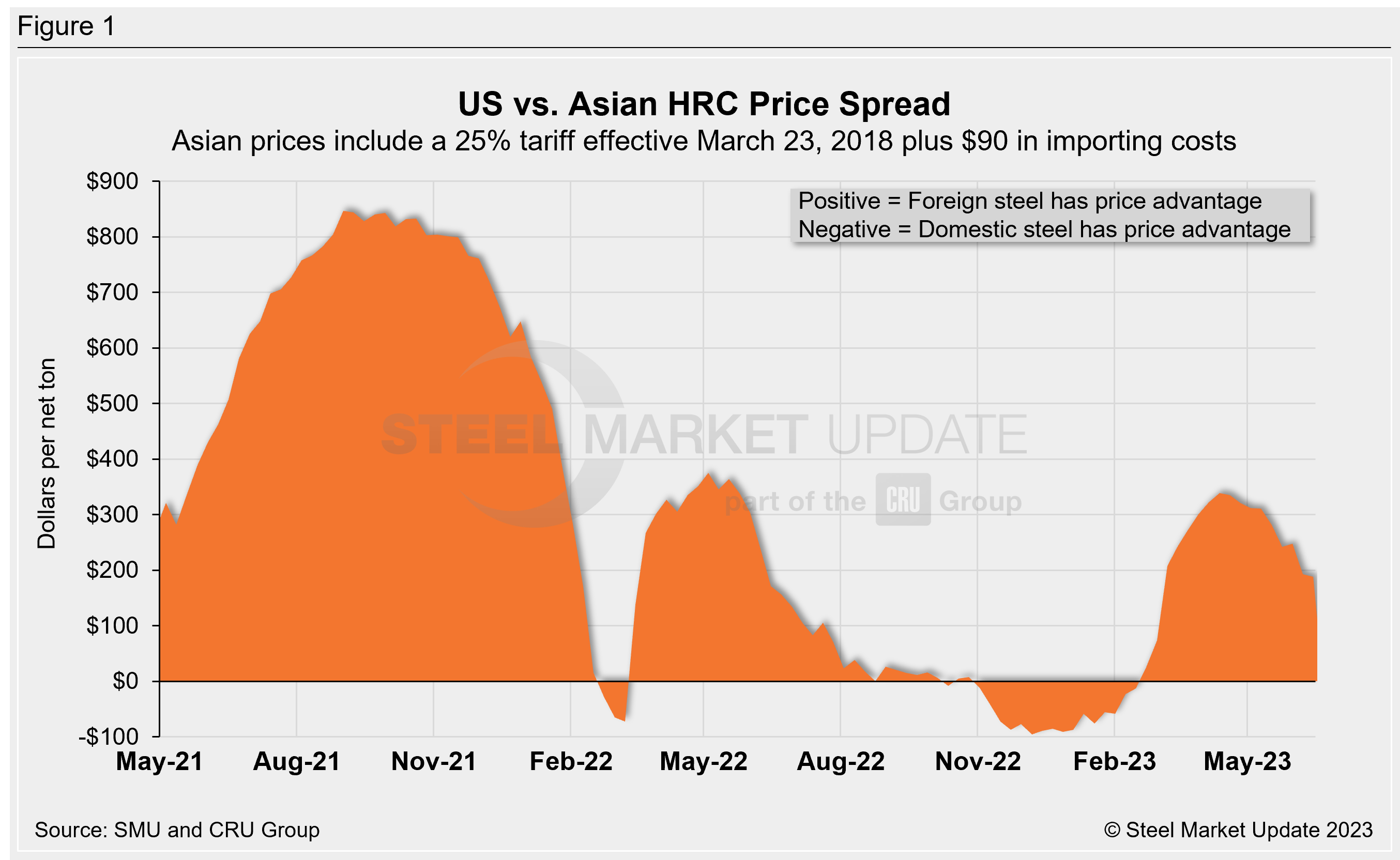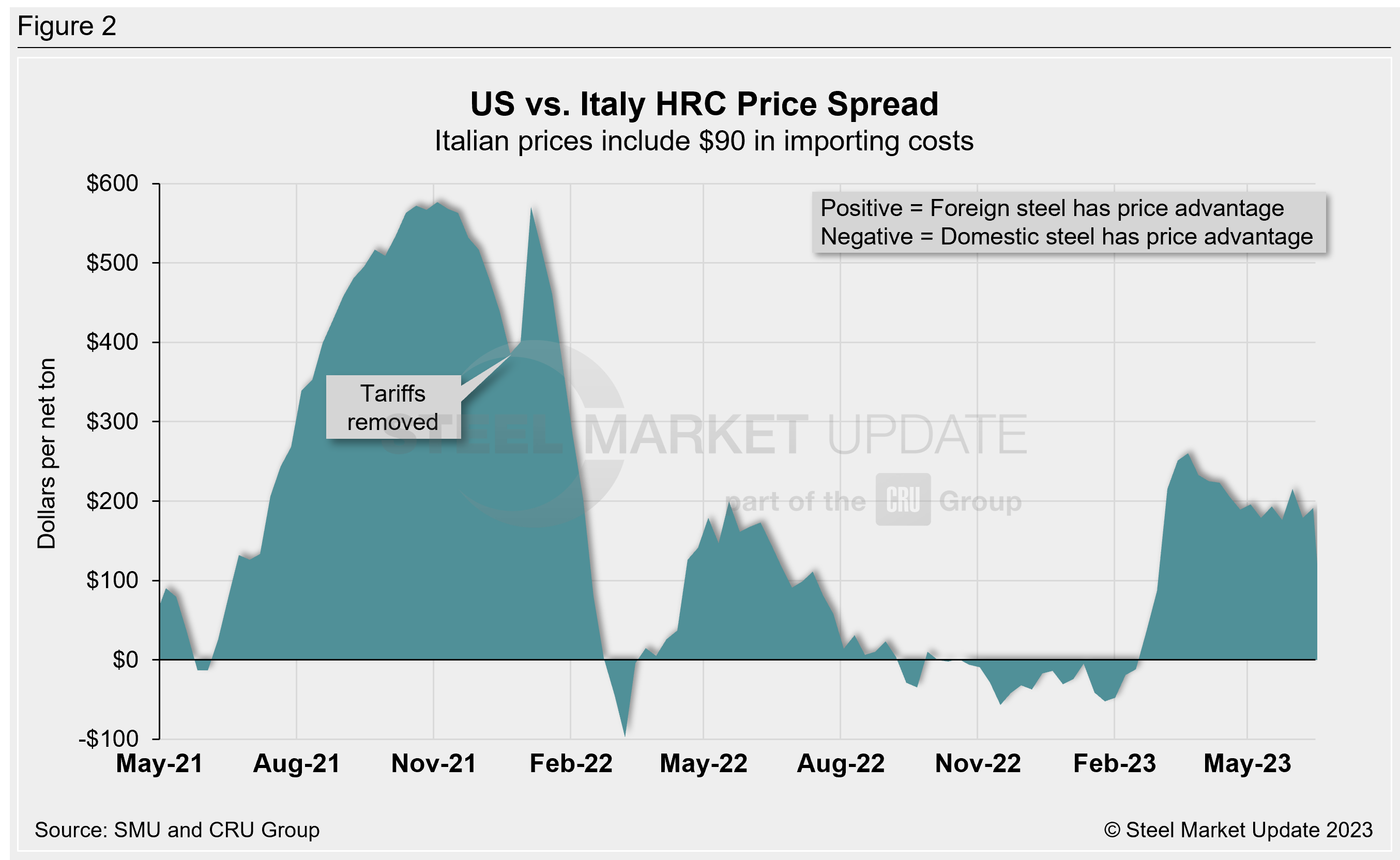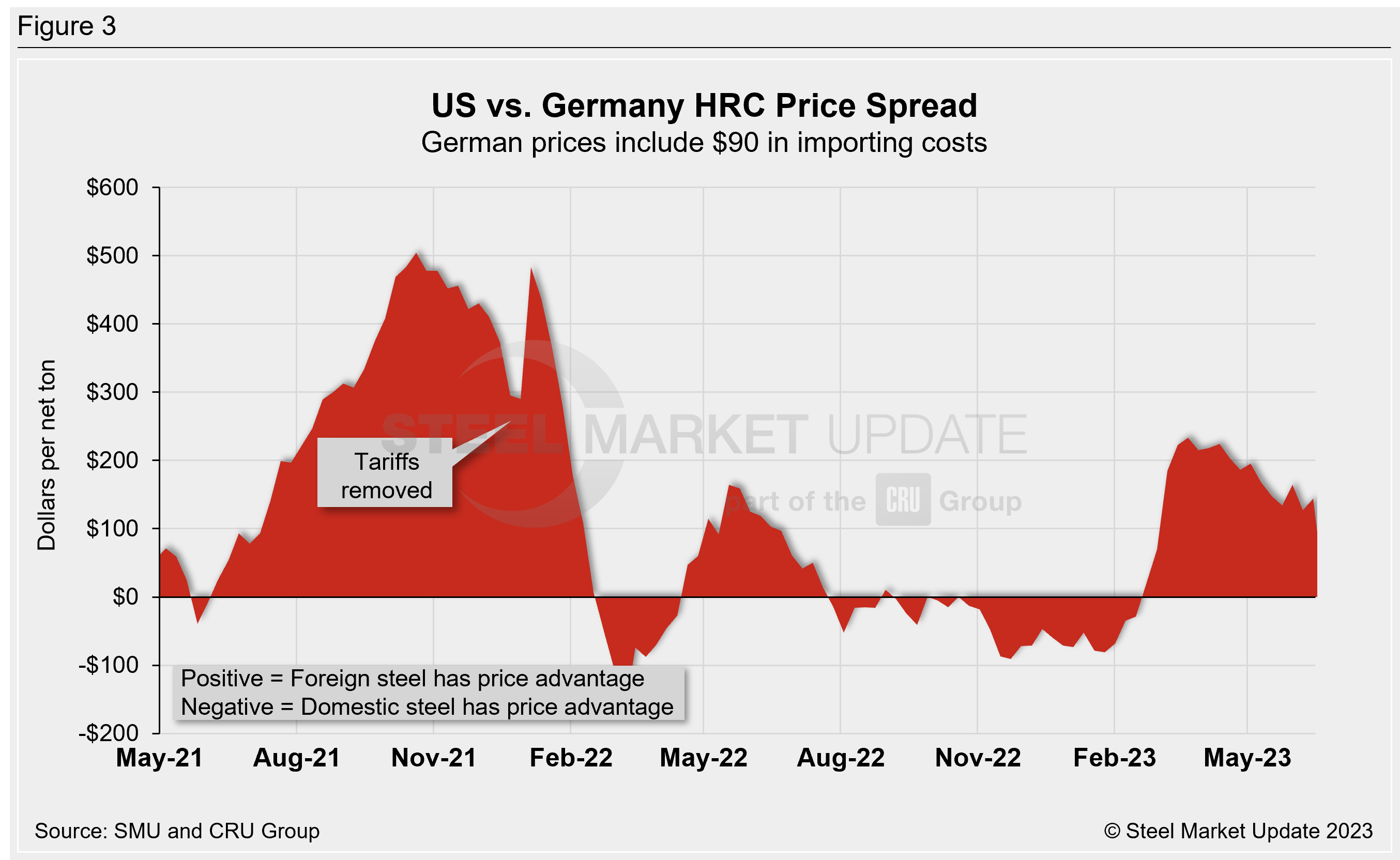International Steel Prices

US Premium Over Foreign Hot Band Grows
Written by David Schollaert
June 16, 2023
Offshore hot-rolled coil (HRC) remains at a discount to domestic product, as prices abroad have eroded at a faster pace than tags stateside, according to SMU’s latest foreign vs. domestic price analysis.
![]()
While prices of both imported and domestic hot band continue to decline, domestic HRC’s declines have not been consistently as sharp as the falls abroad. The US premium edged back up after it had declined to its lowest margin in over three months last week because sharply lower HRC prices overseas pushed the premium back up a bit.
Domestic HRC held a price advantage over imported material for about four months following the price erosion that closed out 2022. That advantage turned quickly in a flurry of mill tag hikes in Q1. But prices both stateside and abroad have been subsiding quickly. The margin squeeze has not been as sharp as the current downtrend, but that could balloon if domestic mills are successful in the latest efforts to prop up prices.
Domestic hot band is now roughly 18.7% more expensive than foreign material. That premium is up from last week when domestic HRC was 17.8% more costly than imported product.
As recently as Feb. 15, domestic HRC cost on average $18 per ton less than imported hot band. That flipped mid-Q1, with US prices swelling to be $262 per ton more expensive than offshore product mid-April. The premium is now down $96 per ton, as domestic prices are on average $166 per ton more expensive than imported hot band.
SMU uses the following calculation to identify this theoretical spread between foreign HRC prices (delivered to US ports) and domestic HRC prices (FOB domestic mills): Our analysis compares the SMU US HRC weekly index to the CRU HRC weekly indices for Germany, Italy, and east and southeast Asian ports. This is only a theoretical calculation because costs to import can vary greatly, influencing the true market spread.
In consideration of freight costs, handling, and trader margin, we add $90 per ton to all foreign prices to provide an approximate CIF US ports price to compare to the SMU domestic HRC price. Buyers should use our $90-per-ton figure as a benchmark and adjust up or down based on their own shipping and handling costs. If you import steel and want to share your thoughts on these costs, we welcome your insight at david@steelmarketupdate.com.
Asian Hot-Rolled Coil (East and Southeast Asian Ports)
As of Thursday, June 15, the CRU Asian HRC price was unchanged from the prior week, holding at $522 per ton for a second consecutive week, down $14 per ton from levels one month prior. Adding a 25% tariff and $90 per ton in estimated import costs, the delivered price of Asian HRC to the US is approximately $742 per ton. The latest SMU hot rolled average is $930 per ton, down $5 per ton from our previous price update, and down $110 per ton compared to our price one month ago.
US-produced HRC is now theoretically $188 per ton more expensive than steel imported from Asia. That figure is down $5 per ton WoW. This is still a reversal from mid-February when domestic HRC had a $13-per-ton advantage over HRC from Asian markets.

Italian Hot-Rolled Coil
Italian HRC prices decreased WoW by $17 per ton to $649 per ton this week, and are now down $107 per ton month-on-month (MoM). After adding import costs, the delivered price of Italian HRC is approximately $739 per ton.
Domestic HRC is now theoretically $191 per ton more expensive than imported Italian HRC. That spread is up $12 per ton WoW and represents more than a $200-per-ton reversal compared to just a little over three months ago when US HRC was $12 per ton cheaper than Italian hot band.

German Hot-Rolled Coil
CRU’s latest German HRC price slipped by $22 per ton WoW to $696 per net ton, down $106 per ton MoM. After adding import costs, the delivered price of German HRC is roughly $786 per ton.
Domestic HRC is now theoretically $144 per ton more expensive than imported German HRC. That’s up $17 per ton WoW – a swing of $173 per ton given that German hot band was $29 per ton more costly than domestic HRC in mid-February.

Figure 4 compares all four price indices and highlights the effective date of the 232 tariffs. The chart on the left shows historical variation from Jan. 1, 2021, through present. The chart on the right zooms in to highlight this year’s decoupling of US and offshore HRC prices.

Notes: Freight is an important consideration in deciding whether to import foreign steel or buy from a domestic mill. Domestic prices are referenced as FOB the producing mill, while foreign prices are CIF the port (Houston, NOLA, Savannah, Los Angeles, Camden, etc.). Inland freight, from either a domestic mill or from the port, can dramatically impact the competitiveness of both domestic and foreign steel. It’s also important to factor in lead times. In most markets, domestic steel will deliver more quickly than foreign steel.
Effective Jan. 1, 2022, the traditional Section 232 tariff no longer applies to most imports from the European Union. it has been replaced by a tariff rate quota (TRQ). Therefore, the German and Italian price comparisons in this analysis no longer include a 25% tariff. SMU still includes the 25% Section 232 tariff on foreign prices from other countries. We do not include any antidumping (AD) or countervailing duties (CVD) in this analysis.
By David Schollaert, david@steelmarketupdate.com

David Schollaert
Read more from David SchollaertLatest in International Steel Prices

US and offshore HRC prices tick lower
The threat of tariffs over the past two months has been a springboard for US prices. But the Section 232 reinstatement on March 13 narrowed the domestic premium over imports on a landed basis.

Domestic CRC prices surge ahead of imports
The price spread between stateside-produced CR and imports reached its widest margin in over a year.

US HR prices rising faster than offshore tags
Hot-rolled (HR) coil prices continued to rally in the US this week, quickly outpacing price gains seen abroad. The result: US hot band prices have grown widely more expensive than imports on a landed basis. The premium US HR tags carry over HR prices abroad now stands at a 14-month high. SMU’s average domestic HR […]

US HR price premium over imports widens
Hot-rolled (HR) coil prices were flat in the US this week, while tags in offshore markets were mostly down.

US HR price premium over imports edges up
The price premium between stateside hot band and landed imports widened slightly this week.
